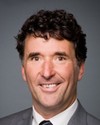For my part, you can probably hear from my accent that I actually grew up in Germany, and I've spent quite a bit of time in both Europe and the United States.
There is the U.S. Green Building Council organization. We do quite a bit of work with them around LEED development and policy development and so on involving green buildings. Things in the United States with regard to green buildings are really accelerating at a rapid pace, both federally now, with the change in the Congress, in the Senate, but also—and this refers back to what you said about cities—there are I don't know how many cities that have signed on now to a climate change agenda in the States, and they are supported by the Clinton Foundation global initiative around climate change. There are 42 cities worldwide now that have signed on to it.
There is a lot of cooperation going on among cities. I haven't seen a similar collaboration in Canada. I know that FCM has Partners for Climate Protection, but it hasn't been as visible. We actually have it in our business plan this year that we want to get the 13 largest cities in Canada together around the issues of green buildings and climate change and around what you are referring to: information sharing and green buildings.
It extends not just to the kind of building but to where we also think about buildings in the community context. Really, what we need is to build cities that are more compact, of higher density, and that also have buildings that perform at a much higher level than they perform right now.
This is really in a nutshell our agenda. We want to start with the 13 largest cities—Toronto and Montreal and so on. Many of them already either have policies in place or are in the process of putting policies in place with regard to green buildings. Often they also commit to LEED.
So in terms of the States, I think we're lagging a little bit behind in this area, but then we are ahead in other areas. There's a lot of capacity, a lot of knowledge and innovation here in Canada when it comes to green buildings and sustainable community development, which we can really draw on. There's a real, I would say, economic cluster forming in Canada with that expertise.
As for the performance of buildings—and I haven't spent as much time in Europe as some other members of our council—we are part of the World Green Building Council as well. It is an international body that brings together councils from across the world. There are currently nine—actually ten members as of this week, including, just this week, the U.K. Green Building Council, which has joined. We have India, the U.S., Australia, New Zealand, the United Emirates, Japan—these are some of the countries that have green building councils and green building rating systems, not necessarily LEED, but their own homemade green building rating systems—and we have Europe as well.
I can tell you that in the European context, what I saw the last time I was over there, last year, is that in terms of energy they are considerably ahead of North America. I have seen different houses. One house is called the passive house, of which they have now built about 6,000 in Austria and Germany. They use only 25% of the energy of our top-rated energy house in Canada. This is a commercialized technology. It is low technology that uses wood frame construction. These kinds of technologies are out there, and it is quite fascinating to see.




